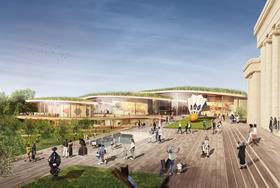
THENEXTWEB.COM
Meet the Dutch tech stars speaking at TNW Conference
As our favourite Dutch holiday approaches, TNW is celebrating the tech titans shaping the future in the Netherlands.
Our beloved home country is the proud parent of a prodigious brood of digital talent. It’s given birth to cultivated meat, raised Booking.com to become the world’s largest online travel agency, and watched with joy as ASML grew into Europe’s most valuable tech company.
The family also includes a gifted group of startups and scaleups. In recent years, economic headwinds, geopolitical turbulence, and questionable government policies have blown some of their progress off course, but Dutch tech continues to punch well above its weight. Just last month, the Netherlands ranked 10th in a global index of tech competitiveness — ahead of every G7 country.
The country also boasts an illustrious list of tech luminaries. Many of them will be at TNW Conference — and so could you. In our spirit of patriotism (and, perhaps, a bit of Dutch courage), we’re offering a ludicrously generous discount on tickets to mark Koningsdag — aka King’s Day, an orange-infused celebration of the monarch’s birthday.
You can find all the details on the offer at the bottom of this article. But first, we want to introduce you to eight Dutch tech leaders who will grace the stages of TNW Conference on June 19 and 20.
The 💜 of EU techThe latest rumblings from the EU tech scene, a story from our wise ol' founder Boris, and some questionable AI art. It's free, every week, in your inbox. Sign up now!1. Peter Wennink
A legend of Dutch tech, Peter Wennink led chip giant ASML to become the most valuable tech firm in Europe.
Over his 25-year career at the Veldhoven-based business — including over a decade as CEO — ASML earned acclaim as the world’s only supplier and producer of extreme ultraviolet (EUV) lithography machines.
These systems are essential for manufacturing the world’s most advanced chips. They’ve become a crucial force behind countless innovations, from iPhones and MacBooks to autonomous vehicles and Nvidia GPUs.
On the TNW stage, Wennink will speak in an exclusive session titled “Gods of Industry: The Battle for Deep Tech Dominance.” He’ll be joined by Young Sohn, the founding managing partner of Walden Catalyst Ventures, a VC fund dedicated to deep tech.
The duo will give a glimpse into a future that is hard for most of us to even imagine.
“It’s difficult for mankind to foresee the impact of exponentiality because it often yields something seemingly impossible,” Wennink told TNW. “But that’s exactly what science and deep tech will create, making the impossible possible.”
2. Vidya Peters
As the CEO of Dutch unicorn DataSnipper, Vidya Peters has overseen the scaleup’s rise to become the fastest-growing tech company in the Netherlands for two years.
Under her leadership, DataSnipper has become a global force in audit and finance automation. Over 500,000 professionals across more than 125 countries now use its software.
After honing her expertise in Silicon Valley, Peters has also become a powerful advocate for European tech. Rather than merely mimicking US tech, she urges startups and scaleups to embrace the continent’s strengths. A key one is sustainable, long-term growth.
“Five years ago, it wasn’t very fashionable to be profitable,” Peters told TNW. “But I think this is where the European sensibility is a strength, because European companies have always taken this approach, and now it’s hugely valued in the current economic climate.”
Peters has also guided DataSnipper’s adoption of artificial intelligence. At TNW Conference, she’ll share her learnings in a session titled “AI’s Big Glow-Up: Generating Ideas, Innovation, and Impact.”
Vidya Peters, the CEO of DataSnipper, flanked by the company’s three founders. Credit: DataSnipper
3. Daan Klein Douwel
Joining Peters in her session will be Daan Klein Douwel, the head of data and AI at one of the biggest companies in the Netherlands: KLM Royal Dutch Airlines.
Klein Douwel drives the company’s efforts to leverage the power of AI and data. KLM has applied these technologies to numerous applications, from automating responses to customer enquiries to predicting hand luggage amounts and cutting food waste.
Klein Douwel will take the TNW stage to share practical insights on deploying AI.
4. Robert Doornbos
In Max Verstappen, the Netherlands boasts the reigning four-time Formula 1 World Champion. In Robert Doornbos, TNW boasts one of the drivers who paved the path for Verstappen’s rise.
A former F1 and Indycar driver, Doornbos was a driver for Jordan and Red Bull Racing — Max Verstappen’s team. He was also Minardi’s last-ever race driver. Today, he’s a renowned F1 analyst.
His career in motorsports has given him unique insights into vehicle technology. He’ll join TNW Conference to explore the future of mobility in a talk titled “The Road Ahead: Driving Innovation and Sustainability.”
5. Jacqueline van den Ende
Jacqueline van den Ende is playing a powerful role in fostering impactful companies.
She’s the co-founder and CEO of Carbon Equity, an investment platform that unlocks private capital to solve one of the world’s greatest challenges: climate change.
Earlier this month, the platform announced that it had raised €105mn for its Climate Tech Portfolio Fund III.
“Despite the current geopolitical uncertainty, we have raised over €100mn within a year for innovative climate solutions. I’m proud of that,” van den Ende said.
“It also confirms that the momentum for investing in climate technology continues. The energy transition is already in full swing — not driven by idealism, but simply because sustainable solutions are economically smarter.”
She’ll explore the challenges and opportunities for venture capital in a conference session titled “Off with Their Heads: Death to the VC & Building Smarter Investment Models.”
6. Marc Wesselink
Joining van den Ende in her session will be Marc Wesselink, the co-founder of Venturerock, an all-in-one investment and venture-building platform.
A serial entrepreneur, Wesselink has launched 12 companies. He’s also failed with four, gaining valuable insights about the startup world. In addition to his role at Venturerock, Wesselink is a founding partner at Startupbootcamp, responsible for its alumni portfolio. He’s now using those experiences to build a new way to fund global startups and scaleups.
Wesselink will take the stage at TNW Conference to explain how Europe can challenge the old-school VC playbook and explore alternative funding models.
7. Jeroen van Glabbeek
As the CEO and founder of CM.com, Jeroen van Glabbeek has built a global leader in cloud software for conversational commerce.
Van Glabbeek has an ambitious goal: to create the world’s best platform for mobile messaging, payments, voice, apps, and security.
His company recently introduced the next step of this mission: HALO — an agentic AI tool for automating business tasks, boosting productivity, and scaling businesses.
He’ll speak at TNW Conference in a session titled “Death of the Unicorn: Can Europe Learn to Love Rapid Growth?” The discussion will highlight real-world success stories that prove scaling within Europe is possible — and what’s holding the continent back.
Van Glabbeek will also be joining the Assembly — an exclusive, invite-only gathering of policymakers and business leaders at TNW Conference.
8. Monika Tomczak-Gorlikowska
Monika Tomczak-Gorlikowska is one of Europe’s leading experts on data privacy.
A licensed attorney who practised data privacy law for over 20 years, Tomczak-Gorlikowska has served as a legal counsel for the EU and Shell. She’s now the Chief Privacy Officer at Prosus Group — a global consumer internet group and one of the largest technology investors in the world.
She’ll join TNW Conference for a session titled “Innovation at Scale: The Future of Global Enterprise.” Alongside Shez Partovi, the Chief Innovation and Strategy Officer at Philips, she’ll share actionable strategies to drive sustainable growth, adapt to emerging trends, and thrive in a competitive marketplace.
To find out more about TNW Conference, check out our full speaker list, agenda, tickets page, and media hub.
Still here? Then you’ve earned yourself a big discount on tickets to TNW Conference, which takes place on June 19 and 20 in Amsterdam. Use the code ORANJEBOVEN at the checkout to get 40% off your pass.
Story by
Thomas Macaulay
Managing editor
Thomas is the managing editor of TNW. He leads our coverage of European tech and oversees our talented team of writers. Away from work, he e
(show all)
Thomas is the managing editor of TNW. He leads our coverage of European tech and oversees our talented team of writers. Away from work, he enjoys playing chess (badly) and the guitar (even worse).
Get the TNW newsletter
Get the most important tech news in your inbox each week.
Also tagged with
0 Yorumlar
0 hisse senetleri
24 Views











